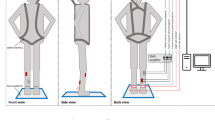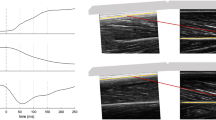Abstract
The representation of the vertical can be assessed by measuring the visual, tactile or perception of the postural vertical (PV). It is well accepted that visceral graviceptors and Golgi tendon receptors contribute to perception of the PV, whereas the role of muscular proprioception (Ia muscle spindles) remains to be clarified. The objective of this study was to analyze whether or not muscular proprioception contributes to the representation of verticality. We hypothesized that the modulation of proprioception by appropriate tendinomuscular vibration may tilt the PV. We present two experiments that explore this hypothesis. PV was firstly measured in the pitch plane in twelve healthy subjects in two conditions: baseline and vibration of both Achilles tendons during six minutes, according to a counterbalanced presentation. PV orientation (mean) and dispersion (standard deviation) were calculated on the six measurements per condition. Vibration of the Achilles tendons induced a systematic backward tilt of PV (2.7° ± 0.8° on average; P < 10−3), and no significant changes regarding PV dispersion. A clear post-effect was found for PV orientation in subjects who started the experiment with the condition vibration on. The possibility that PV could also be modulated by a much shorter duration of vibration (less than 8 s of vibration) was analyzed in a second experiment using a similar general procedure but a simplified experimental plane in other subjects. Again a backward PV tilt was induced by the vibration, but with a magnitude lower than that found in the first experiment, and with no post-effect. Since body geometry was unchanged, these two studies mean that proprioception contributes to the representation of the vertical. In conclusion, this study brings new insights to our understanding of the sense of verticality and contributes to the interpretation of backward falls induced by vibration. The induced backward fall is partly due to alignment of the erect posture with a backward-tilted referential of verticality.




Similar content being viewed by others
References
Anastasopoulos D, Haslwanter T, Bronstein A, Fetter M, Dichgans J (1997) Dissociation between the perception of body verticality and the visual vertical in acute peripheral vestibular disorder in humans. Neurosci Lett 233:151–153
Benson AJ, Hutt EC, Brown SF (1989) Thresholds for the perception of whole body angular movement about a vertical axis. Aviat Space Environ Med 60:205–213
Bisdorff AR, Wolsley CJ, Anastasopoulos D, Bronstein AM, Gresty MA (1996) The perception of body verticality (subjective postural vertical) in peripheral and central vestibular disorders. Brain 119(Pt 5):1523–1534
Bove M, Nardone A, Schieppati M (2003) Effects of leg muscle tendon vibration on group Ia and group II reflex responses to stance perturbation in humans. J Physiol 550:617–630
Bringoux L, Nougier V, Barraud PA, Marin L, Raphel C (2003) Contribution of somesthetic information to the perception of body orientation in the pitch dimension. Q J Exp Psychol A 56:909–923
Bronstein AM (1999) The interaction of otolith and proprioceptive information in the perception of verticality. The effects of labyrinthine and CNS disease. Ann N Y Acad Sci 871:324–333
Bronstein AM, Perennou DA, Guerraz M, Playford D, Rudge P (2003) Dissociation of visual and haptic vertical in two patients with vestibular nuclear lesions. Neurology 61:1260–1262
Burke D, Hagbarth KE, Lofstedt L, Wallin BG (1976) The responses of human muscle spindle endings to vibration of non-contracting muscles. J Physiol 261:673–693
Capicikova N, Rocchi L, Hlavacka F, Chiari L, Cappello A (2006) Human postural response to lower leg muscle vibration of different duration. Physiol Res 55(Suppl 1):S129–S134
Ceyte H, Cian C, Zory R, Barraud PA, Roux A, Guerraz M (2007) Effect of Achilles tendon vibration on postural orientation. Neurosci Lett 416:71–75
Clark B, Graybiel A (1963) Perception of the postural vertical in normals and subjects with labyrinthine defects. J Exp Psychol 65:490–494
Courtine G, Pozzo T, Schieppati M (2001) Rémanence de l’effet vibratoire durant la marche humaine. Journal de la Société de Biologie 195:443–446
Dietz V, Gollhofer A, Kleiber M, Trippel M (1992) Regulation of bipedal stance: dependency on “load” receptors. Exp Brain Res 89:229–231
Duclos C, Roll R, Kavounoudias A, Roll JP, Forget R (2007) Vibration-induced post-effects: a means to improve postural asymmetry in lower leg amputees? Gait Posture
Eklund G (1972) General features of vibration-induced effects on balance. Ups J Med Sci 77:112–124
Gilhodes JC, Roll JP, Tardy-Gervet MF (1986) Perceptual and motor effects of agonist-antagonist muscle vibration in man. Exp Brain Res 61:395–402
Goodwin GM, McCloskey DI, Matthews PB (1972) Proprioceptive illusions induced by muscle vibration: contribution by muscle spindles to perception? Science 175:1382–1384
Hlavacka F, Krizkova M, Horak FB (1995) Modification of human postural response to leg muscle vibration by electrical vestibular stimulation. Neurosci Lett 189:9–12
Ivanenko YP, Solopova IA, Levik YS (2000) The direction of postural instability affects postural reactions to ankle muscle vibration in humans. Neurosci Lett 292:103–106
Kavounoudias A, Gilhodes JC, Roll R, Roll JP (1999) From balance regulation to body orientation: two goals for muscle proprioceptive information processing? Exp Brain Res 124:80–88
Kavounoudias A, Roll R, Roll JP (1998) The plantar sole is a “dynamometric map” for human balance control. Neuroreport 9:3247–3252
Manckoundia P, Mourey F, Pfitzenmeyer P, Hoecke JV, Perennou D (2007) Is backward disequilibrium in the elderly caused by an abnormal perception of verticality? A pilot study. Clin Neurophysiol 118:786–793
Massion J (1992) Movement, posture and equilibrium: interaction and coordination. Prog Neurobiol 38:35–56
Mittelstaedt H (1992) Somatic versus vestibular gravity reception in man. Ann N Y Acad Sci 656:124–139
Mittelstaedt H (1998) Origin and processing of postural information. Neurosci Biobehav Rev 22:473–478
Perennou DA, Amblard B, Laassel el M, Benaim C, Herisson C, Pelissier J (2002) Understanding the pusher behavior of some stroke patients with spatial deficits: a pilot study. Arch Phys Med Rehabil 83:570–575
Perennou DA, Amblard B, Leblond C, Pelissier J (1998) Biased postural vertical in humans with hemispheric cerebral lesions. Neurosci Lett 252:75–78
Roll JP, Gilhodes JC, Roll R, Harlay F (1996) Are proprioceptive sensory inputs combined into a “gestalt”? In: Inui TML (ed) Attention and performance XVI: information integration in perception and communication. MIT, Cambridge, pp 291–314
Roll JP, Roll R (1988) From eye to foot. A proprioceptive chain involved in postural control. In: Amblard BBA, Clarac F (eds) Posture and gait. Elsevier, Amsterdam, pp 155–164
Roll JP, Vedel JP, Ribot E (1989) Alteration of proprioceptive messages induced by tendon vibration in man: a microneurographic study. Exp Brain Res 76:213–222
Roll R, Gilhodes JC, Roll JP, Popov K, Charade O, Gurfinkel V (1998) Proprioceptive information processing in weightlessness. Exp Brain Res 122:393–402
Trousselard M, Barraud PA, Nougier V, Raphel C, Cian C (2004) Contribution of tactile and interoceptive cues to the perception of the direction of gravity. Brain Res Cogn Brain Res 20:355–362
Wierzbicka MM, Gilhodes JC, Roll JP (1998) Vibration-induced postural posteffects. J Neurophysiol 79:143–150
Young LR (1984) Perception of the body in space: mechanisms. In: Smith I (ed) Handbook of physiology—the nervous system, vol 3. Academic, New York, pp 1023–1066
Acknowledgments
We are grateful to "La Fondation De L'avenir" and Technoconcept company for their support.
Author information
Authors and Affiliations
Corresponding author
Rights and permissions
About this article
Cite this article
Barbieri, G., Gissot, AS., Fouque, F. et al. Does proprioception contribute to the sense of verticality?. Exp Brain Res 185, 545–552 (2008). https://doi.org/10.1007/s00221-007-1177-8
Received:
Accepted:
Published:
Issue Date:
DOI: https://doi.org/10.1007/s00221-007-1177-8




